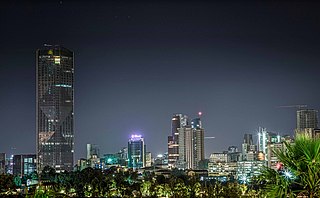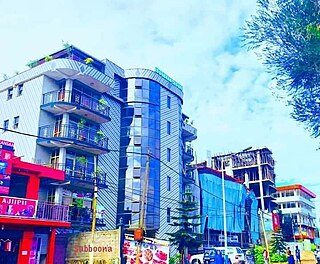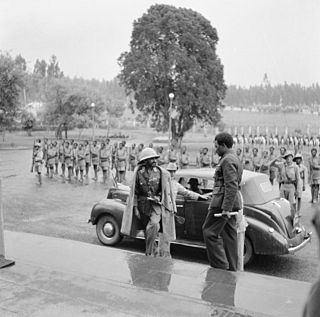
Haile Selassie I was Emperor of Ethiopia from 1930 to 1974. He rose to power as Regent Plenipotentiary of Ethiopia (Enderase) for Empress Zewditu from 1916 until 1930. Haile Selassie is widely considered a defining figure in modern Ethiopian history, and the key figure of Rastafari, a religious movement in Jamaica that emerged shortly after he became emperor in the 1930s. Before he rose to power he defeated Ras Gugsa Wole Bitul of Begemidr at the Battle of Anchem in 1928. He was a member of the Solomonic dynasty, which claims to trace lineage to Emperor Menelik I, believed to be the son of King Solomon and Makeda, the Queen of Sheba.

Addis Ababa is the capital and largest city of Ethiopia. In the 2007 census, the city's population was estimated to be 2,739,551 inhabitants. Addis Ababa is a highly developed and important cultural, artistic, financial and administrative centre of Ethiopia. It also serves as the capital of the Oromia Region.

Lij Iyasu was the designated Emperor of Ethiopia from 1913 to 1916. His baptismal name was Kifle Yaqob. Ethiopian emperors traditionally chose their regnal name on the day they were crowned, and since he was never crowned, he is usually referred to as Lij Iyasu, "Lij" meaning child, especially one born of royal blood.

RasMakonnen Wolde Mikael Wolde Melekot, or simply Ras Makonnen, also known as Abba Qagnew, was an Ethiopian royal from Shewa, a military leader, the governor of Harar, and the father of future Emperor Haile Selassie. Described by Nikolai Gumilev as “one of the greatest leaders of Abyssinia”, he served in the First Italo-Ethiopian War, playing a key role at the Battle of Adwa.

Shewa, formerly romanized as Shua, Shoa, Showa, Shuwa, is a historical region of Ethiopia which was formerly an autonomous kingdom within the Ethiopian Empire. The modern Ethiopian capital Addis Ababa is located at its center.

Ras BetwodedMekonnen Endelkachew was an Ethiopian aristocrat and Prime Minister under Emperor Haile Selassie. Mekonnen was born in Addisge, the nephew of the noted Shewan general and politician Ras Betwoded Tessema Nadew, who introduced him to Emperor Menilek II. He was a member of the alpha class of the Menelik II School in Addis Ababa when it opened in 1908.

Dembidollo, also spelled Dembi Dolo, is a market town and separate woreda in south-western Ethiopia. It is the capital of Kelam Welega Zone of the Oromia Region. This town, which is at an elevation of between 1,701 m (5,581 ft) and 1,827 m (5,994 ft) above sea level, was originally known as Sayo.

Nekemte, also spelled as Neqemte, is a market city and separate woreda in western Ethiopia. Located in the East Welega Zone of the Oromia Region, Nekemte has a latitude and longitude of 9°5′N36°33′E and an elevation of 2,088 meters.

RasDesta Damtew KBE was an Ethiopian noble, an army commander, and a son-in-law of Emperor Haile Selassie I. He is known for his leadership in the Ethiopian Army during the Second Italo-Ethiopian War. He was executed on 24 February 1937, by the Italian Armed Forces shortly after Ethiopia's loss in the war.

The history of Addis Ababa, capital of Ethiopia, formally begins with the founding of the city in the 19th century by Ethiopian Emperor Menelik II and his wife Empress Taytu Betul. In its first years the city was more like a military encampment than a town. The central focus was the emperor’s palace, which was surrounded by the dwellings of his troops and of his innumerable retainers. In the 1920s, Addis Ababa experienced a significant economic upturn, marked by a surge in the number of middle-class-owned buildings, including stone houses furnished with imported European furniture. The middle class also introduced newly manufactured automobiles and expanded banking institutions. Urbanization and modernization persisted during the Italian occupation, guided by a masterplan aimed at transforming Addis Ababa into a more "colonial" city, a trajectory that continued beyond the occupation. Subsequent master plans, formulated from the 1940s onward with the input of European consultants, focused on the development of monuments, civic structures, satellite cities, and the inner city.

DejazmachBalcha Safo, popularly referred to by his horse-name Abba Nefso, was an Ethiopian military commander and lord protector of the crown, who served in both the First and Second Italo-Ethiopian Wars.

Ethiopia is a landlocked sovereign country located in the Horn of Africa. Ethiopia is bordered by Eritrea to the north, Sudan to the west, South Sudan to the south-west, Kenya to the south, Somalia to the east and Djibouti to the north-east. Ethiopia is one of the oldest countries in the world and Africa's second-most populous nation. Ethiopia has yielded some of humanity's oldest traces, making the area important in the history of human evolution. Recent studies claim that the vicinity of present-day Addis Ababa was the point from which human beings migrated around the world. Ethiopian dynastic history traditionally began with the reign of Emperor Menelik I in 1000 BC. The roots of the Ethiopian state are similarly deep, dating with unbroken continuity to at least the Aksumite Empire and its predecessor state, D`mt. After a period of decentralized power in the 18th and early 19th centuries known as the Zemene Mesafint, the country was reunited in 1855 by Kassa Hailu, who became Emperor Tewodros II, beginning Ethiopia's modern history. Ethiopia's borders underwent significant territorial expansion to its modern borders for the rest of the century, especially by Emperor Menelik II and Ras Gobena, culminating in its victory over the Italians at the Battle of Adwa in 1896 with the military leadership of Ras Makonnen, and ensuring its sovereignty and freedom from colonization. It was occupied by Benito Mussolini's Fascist Italy from 1936 to 1941, ending with its liberation by British Empire and Ethiopian Patriot forces. Its eastern border also changed in 1950 from the former 1908 Convention Line to the subsequent provisional administrative line.
Hailu Tekle Haymanot, also named Hailu II of Gojjam, was an army commander and a member of the nobility of the Ethiopian Empire. He represented a provincial ruling elite who were often at odds with the Ethiopian central government. Hailu Tekle Haymanot was an independent-minded potentate who, throughout his life, was mistrustful of and mistrusted by the Emperor.

LijAbiye Abebe was an Ethiopian politician and son-in-law of Emperor Haile Selassie.

The 1960 Ethiopian coup d'etat attempt was perpetrated against Emperor Haile Selassie on 13 December 1960. The Council of the Revolution, four conspirators led by brothers Germame Neway and Brigadier General Mengistu Neway, commander of the Kebur Zabagna, sought to overthrow the Emperor during a state visit to Brazil in order to install a progressive government. The coup leaders declared the beginning of a new government under the rule of Haile Selassie's eldest son, Crown Prince Asfaw Wossen, that would address the numerous economic and social problems Ethiopia faced. The Council gained control of most of the capital city, Addis Ababa, and took several ministers and other important people hostage. After its initial success, the majority of the military and populace quickly aligned against the coup, and by 17 December loyalists had regained control of Addis Ababa. At least 300 people were killed during the coup, including most of the conspirators.

Yekatit 12 is a date in the Ge'ez calendar which refers to the massacre and imprisonment of Ethiopians by the Italian occupation forces following an attempted assassination of Marshal Rodolfo Graziani, Marquis of Negele, Viceroy of Italian East Africa, on 19 February 1937. Graziani had led the Italian forces to victory over the Ethiopians in the Second Italian invasion of Ethiopia and was supreme governor of Italian East Africa. This has been described as the worst massacre in Ethiopian history.

Italians of Ethiopia are Ethiopian-born citizens who are fully or partially of Italian descent, whose ancestors were Italians who emigrated to Ethiopia starting in the 19th century during the Italian diaspora, or Italian-born people in Ethiopia.

Prince Joel David Makonnen Haile Selassie of Ethiopia is an attorney, businessman, philanthropist, writer, and member of the Ethiopian Imperial House of Solomon. He is the great-grandson of Haile Selassie I, the last Emperor of Ethiopia. Makonnen was born in exile in Rome and grew up in Switzerland and France, attending both the Collège du Léman in Geneva and Sainte Croix des Neiges in Haute Savoie. In 1999, he returned to Ethiopia with his mother, living in Addis Ababa. He moved to the United States and, in 2009, worked as the director of grants for Humanities DC, a non-profit affiliate of the National Endowment for the Humanities. He was a legal intern at the United Nations in 2011 and worked as a law clerk in international trade and equal opportunity employment in 2013. Since 2017, makonnen has served as a legal aid and corporate counsel for Otsuka Pharmaceutical. He is the co-founder and director of Alchemy World Projects USA, an educational and entrepreneurship organization that serves impoverished youth in Ethiopia, and is the co-founder of the media company Old World/New World Productions, which he launched with his wife, Ariana Austin Makonnen. In 2021, he co-authored a children's novel with Kwame Mbalia titled Last Gate of the Emperor.

The relations between Oromia and Addis Ababa has been great controversy as the subject sparked historical revisionism in the linkage of history of Addis Ababa. The area in the present day Addis Ababa called Finfinne where various Oromo pastoralists inhabited the region, and the emergence of Abyssinian expansionism under Emperor Menelik II which renamed the area as Addis Ababa in 1886. Throughout the 20th century, Addis Ababa was governed as the capital city of the Ethiopia under urban influence.
This is chronology of the Ethiopian Revolution that took place from 12 January to 12 September 1974 in the Ethiopian Empire.


















